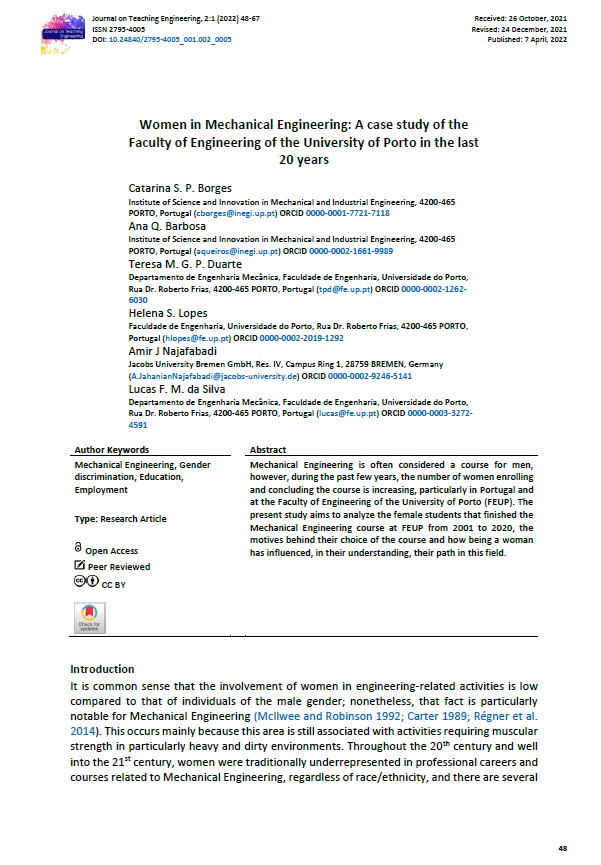Women in Mechanical Engineering: A case study of the Faculty of Engineering of the University of Porto in the last 20 years
Main Article Content
Abstract
Mechanical Engineering is often considered a course for men, however, during the past few years, the number of women enrolling and concluding the course is increasing, particularly in Portugal and at the Faculty of Engineering of the University of Porto (FEUP). The present study aims to analyse the female students that finished the Mechanical Engineering course at FEUP from 2001 to 2020, the motives behind their choice of the course and how being a woman has influenced, in their understanding, their path in this field.
Article Details

This work is licensed under a Creative Commons Attribution 4.0 International License.
References
(EIGE), European Institute for Gender Equality. "What lies behind the gender pay gap? Gender Statistics Base (2019). https://eige.europa.eu/gender-statistics/dgs/data-talks/what-lies-behind-gender-pay-gap.
A., Lígia, and M. H. Santos. "Gender equality and modernity in Portugal. An analysis on the obstacles to gender equality in highly qualified professions." Social Sciences 10, no. 5 (2021): 162. https://doi.org/10.3390/socsci10050162.
A., Lisa S., and K. A. Gilbride. "Pre-university outreach: Encouraging students to consider engineering careers." Global Journal of Engineering. n 7, no. 1 (2003): 87-93.
Aronson, Joshua. "The threat of stereotype." Educational leadership 62 (2004): 14-20.
Aronson, J., M. J. Lustina, C. Good, K. Keough, C. M. Steele, and J. Brown. "When white men can't do math: Necessary and sufficient factors in stereotype threat." Journal of experimental social psychology 35, no. 1 (1999): 29-46. https://doi.org/10.1006/jesp.1998.1371.
Barreto, A. "Portugal na periferia do centro: mudança social, 1960 a 1995." Análise social (1995): 841-855.
Beleza, T. P. Direito das mulheres e da igualdade social a construção jurídica das relações de género: uma proposta de estudo e de ensino. Almedina, 2010.
Cadaret, M. C., P. J. Hartung, L. M. Subich, and I. K. Weigold. "Stereotype threat as a barrier to women entering engineering careers." Journal of Vocational Behavior 99 (2017): 40-51. https://doi.org/10.1016/j.jvb.2016.12.002.
Carter, R. Women in engineering: A good place to be?. Macmillan International Higher Education, 1989.
Casad, B. J., P. Hale, and F. L. Wachs. "Stereotype threat among girls: Differences by gender identity and math education context." Psychology of Women Quarterly 41, no. 4 (2017): 513-529. https://doi.org/10.1177/0361684317711412.
Evans, S. M. "Sons, daughters, and patriarchy: Gender and the 1968 generation." The American Historical Review 114, no. 2 (2009): 331-347.
Fundação Francisco Manuel dos Santos. 2021. "Diplomados no ensino superior: total e por sexo." Pordata. Last Modified 8 of March, 2021. Accessed 9 of September 2021. https://www.pordata.pt/Portugal/Diplomados+no+ensino+superior+total+e+por+sexo-664.
Hoh, Y. K. "Outstanding women in mechanical engineering." International Journal of Mechanical Engineering Education 35, no. 3 (2007): 198-206. https://doi.org/10.7227/IJMEE.35.3.4.
Kar, S. B., C. A. Pascual, and K. L. Chickering. "Empowerment of women for health promotion: a meta-analysis." Social Science & Medicine 49, no. 11 (1999): 1431-1460. https://doi.org/10.1016/S0277-9536(99)00200-2.
Kaufmann-McCall, D. "Politics of difference: The women's movement in France from May 1968 to Mitterrand." Signs: Journal of Women in Culture and Society 9, no. 2 (1983): 282-293. https://doi.org/10.1086/494048.
Logel, C., G. M. Walton, S. J. Spencer, E. C. Iserman, W. von Hippel, and A. E. Bell. "Interacting with sexist men triggers social identity threat among female engineers." Journal of personality and social psychology 96, no. 6 (2009): 1089. https://doi.org/10.1037/a0015703.
Marques, B. J. S., and I. Guarda. "Tradição e Modernismo na construção da “nova” mulher do Estado Novo português." Estudos Ibero-Americanos 46, no. 2 (2020): 1-17. https://doi.org/10.15448/1980-864X.2020.2.32309.
Marques, M. A., I. M. Duarte, A. G. Pinto, and C. Pinho. "A construção da identidade da mulher em revistas do Estado Novo." (2019).
McIlwee, J. S., and J. G. Robinson. Women in engineering: Gender, power, and workplace culture. SUNY Press, 1992.
Ferreira, V., and T. Tavares. Shifting bonds, shifting bounds: women, mobility and citizenship in Europe. Celta Editora, 1998.
Mendes, J. M. "Class Structure and Intergenerational Mobility in Portugal: the importance of gender and skills." Shifting Bonds, Shifting Bounds. Women, Mobility and Citizenship in Europe. Oeiras: Celta Editora (1998): 315-328.
Naved, R. T. "Empowerment of women: listening to the voices of women." The Bangladesh Development Studies (1994): 155-178.
Nogueira, C., C. Paúl, and L. Amâncio. "Women in management in Portugal: a demographic overview." (1995).
Organisation for Economic Co-operation and Development (OECD). Education at a glance 2021: OECD indicators. Paris: OECD, 2021.
Pimentel, I. F., and H. P. de Melo. Mulheres portuguesas. Clube do Autor, 2015.
Pinto, C. M. A., and C. P. Santos. "Preface of the “Symposium on dynamical systems applications”." In AIP Conference Proceedings, vol. 1648, no. 1, p. 350001. AIP Publishing LLC, 2015. https://doi.org/10.1063/1.4912579.
Rahm, J., and P. Charbonneau. "Probing stereotypes through students’ drawings of scientists." American Journal of Physics 65, no. 8 (1997): 774-778. https://doi.org/10.1119/1.18647.
Ramos, Alexandre. "“Fantastic” colonial cities: Portuguese colonial utopia." In Intelligence, Creativity and Fantasy, pp. 199-204. CRC Press, 2019.
Régner, I., J. R. Steele, N. Ambady, C. Thinus-Blanc, and P. Huguet. "Our future scientists: A review of stereotype threat in girls from early elementary school to middle school." Revue internationale de psychologie sociale 27, no. 3 (2014): 13-51.
Rosas, F. "O salazarismo e o homem novo: ensaio sobre o Estado Novo e a questão do totalitarismo." Análise social (2001): 1031-1054.
Schmader, T. "Gender identification moderates stereotype threat effects on women's math performance." Journal of experimental social psychology 38, no. 2 (2002): 194-201. https://doi.org/10.1006/jesp.2001.1500.
Schmader, T., and M. Johns. "Converging evidence that stereotype threat reduces working memory capacity." Journal of personality and social psychology 85, no. 3 (2003): 440. https://doi.org/10.1037/0022-3514.85.3.440.
Schmader, T., M. Johns, and C. Forbes. "An integrated process model of stereotype threat effects on performance." Psychological review 115, no. 2 (2008): 336. https://dx.doi.org/10.1037%2F0033-295X.115.2.336.
Spencer, S. J., C. M. Steele, and D. M. Quinn. "Stereotype threat and women's math performance." Journal of experimental social psychology 35, no. 1 (1999): 4-28. https://doi.org/10.1006/jesp.1998.1373.

